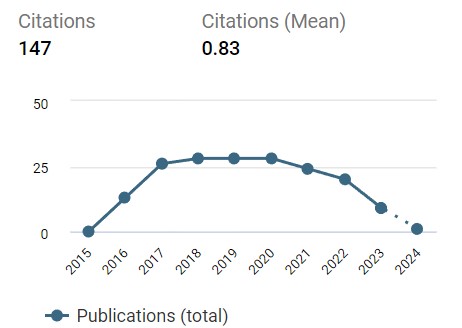QUANTITATIVE MACRO DEFECT ANALYSIS IN SAND CASTING: 3D SIMULATION AND POROSITY ASSESSMENT IN ASHTRAY PATTERNS
DOI:
https://doi.org/10.21831/dinamika.v9i2.77486Keywords:
3D Simulation, Macro Defects, Porosity, Quantitative analysis, Sand CastingAbstract
References
Blondheim, D., & Monroe, A. (2022). Macro Porosity Formation: A Study in High Pressure Die Casting. International Journal of Metalcasting, 16(1), 330–341. https://doi.org/10.1007/s40962-021-00602-x
Chadha, U., Dhaliwal, G. S., Sondi, N. J., Darar, S., Chen, Y., Ram Kishore, S., & Yang, W. C. (2024). Optimization of Process Parameters and Additives for Improved Part Quality in Sand Casting: An Overview. Journal of The Institution of Engineers (India): Series D, 0123456789. https://doi.org/10.1007/s40033-024-00686-9
Giovanni, M. T. Di, Menezes, J. T. O. D., Cerri, E., & Castrodeza, E. M. (2020). Influence of microstructure and porosity on the fracture toughness of Al-Si-Mg alloy. Journal of Materials Research and Technology, 9(2), 1286–1295. https://doi.org/10.1016/j.jmrt.2019.11.055
Ingle, P. D., & Narkhede, B. E. (2018). A Literature Survey of Methods to Study and Analyze the Gating System Design for Its Effect on Casting Quality. Materials Today: Proceedings, 5(2), 5421–5429. https://doi.org/10.1016/j.matpr.2017.12.129
Kuchariková, L., Tillová, E., UhríÄik, M., & Belan, J. (2018). Porosity formation and fatigue properties of AlSiCu cast alloy. MATEC Web of Conferences, 157, 1–9. https://doi.org/10.1051/matecconf/201815707003
Li, Y., Liu, J., Huang, W., & Zhang, S. (2022). Microstructure related analysis of tensile and fatigue properties for sand casting aluminum alloy cylinder head. Engineering Failure Analysis, 136(June 2021), 106210. https://doi.org/10.1016/j.engfailanal.2022.106210
Neuser, M., Grydin, O., Andreiev, A., & Schaper, M. (2021). Effect of solidification rates at sand casting on the mechanical joinability of a cast aluminium alloy. Metals, 11(8). https://doi.org/10.3390/met11081304
Rajkumar, I., Rajini, N., Alavudeen, A., Ram Prabhu, T., Ismail, S. O., Mohammad, F., & Al-Lohedan, H. A. (2021). Experimental and simulation analysis on multi-gate variants in sand casting process. Journal of Manufacturing Processes, 62(December 2020), 119–131. https://doi.org/10.1016/j.jmapro.2020.12.006
Raza, M. H., Wasim, A., Sajid, M., & Hussain, S. (2021). Investigating the effects of gating design on mechanical properties of aluminum alloy in sand casting process. Journal of King Saud University - Engineering Sciences, 33(3), 201–212. https://doi.org/10.1016/j.jksues.2020.03.004
Samuel, A. M., & Samuel, F. H. (1992). Various aspects involved in the production of low-hydrogen aluminium castings. Journal of Materials Science, 27(24), 6533–6563. https://doi.org/10.1007/BF01165936
Samuel, A., Zedan, Y., Doty, H., Songmene, V., & Samuel, F. H. (2021). A Review Study on the Main Sources of Porosity in Al-Si Cast Alloys. Advances in Materials Science and Engineering, 2021. https://doi.org/10.1155/2021/1921603
Sertucha, J., & Lacaze, J. (2022). Casting Defects in Sand"Mold Cast Irons"”An Illustrated Review with Emphasis on Spheroidal Graphite Cast Irons. Metals, 12(3), 1–80. https://doi.org/10.3390/met12030504
Singh, A. K., Soni, S., & Rana, R. S. (2020). A Critical Review on Synthesis of Aluminum Metallic Composites through Stir Casting: Challenges and Opportunities. Advanced Engineering Materials, 22(10). https://doi.org/10.1002/adem.202000322
Tammas-Williams, S., Withers, P. J., Todd, I., & Prangnell, P. B. (2017). The Influence of Porosity on Fatigue Crack Initiation in Additively Manufactured Titanium Components. Scientific Reports, 7(1), 1–13. https://doi.org/10.1038/s41598-017-06504-5





